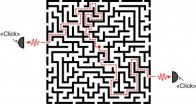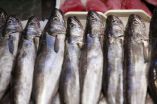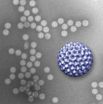(Press-News.org) Researchers at the Niels Bohr Institute have demonstrated that photons (light particles) emitted from light sources embedded in a complex and disordered structure are able to mutually coordinate their paths through the medium. This is a consequence of the photons' wave properties, which give rise to the interaction between different possible routes. The results are published in the scientific journal, Physical Review Letters.
The real world is complex and messy. The research field of photonics, which explores and exploits light, is no exception, and in, for example, biological systems the statistical disorder is unavoidable.
Drunken people and photons
"We work with nanophotonic structures in order to control the emission and propagation of photons. We have discovered in the meantime, that inevitable inaccuracies in the structures lead to random scattering. As a consequence, the transport of photons follow a random path – like a drunken man staggering through the city's labyrinthine streets after an evening in the pub," explains David García, postdoc in Quantum Photonics at the Niels Bohr Institute at the University of Copenhagen.
If we continue with this analogy, then it is not certain that just because one drunken man comes home safely, then a whole crowd of drunken people spreading out from the pub will also find their way through the city's winding streets. There is no relationship between the different random travellers.
But there is when you are talking about photons. They can 'sense' each other and coordinate their travel through a material, according to new research.
"We have inserted a very small light source in a nanophotonic structure, which contains disorder in the form of a random collection of light diffusing holes. The light source is a so-called quantum dot, which is a specially designed nanoscopic light source that can emit photons. The photons are scattered in all directions and are thrown back and forth. But photons are not just light particles, they are also waves, and waves interact with each other. This creates a link between the photons and we can now demonstrate in our experiments that the photons' path through the material is not independent from the other photons," explains David García.
Spectroscopy of complex materials
By analysing the path of the photons through the medium valuable insight is potentially gained about microscopic complex structures.
"The method could be a new way to measure the spatial properties of complex disordered materials, like biological tissue, and since the light sources are very small, you will be able to place them without destroying the material and you have the potential for very high spatial resolution," explains David García.
INFORMATION:
Physical Review Letters: http://prl.aps.org/abstract/PRL/v109/i25/e253902
Contact:
P. David García
PhD, Quantum physicist
Quantum Photonics Group
Niels Bohr Institute
University of Copenhagen
45-353-25-318, 45-269-69-016
garcia@nbi.ku.dk
Web: www.quantum-photonics.dk
The paths of photons are random -- but coordinated
2012-12-20
ELSE PRESS RELEASES FROM THIS DATE:
Italian wolves prefer pork to venison
2012-12-20
Some European wolves have a distinct preference for wild boar over other prey, according to new research.
Scientists from Durham University, UK, in collaboration with the University of Sassari in Italy, found that the diet of wolves was consistently dominated by the consumption of wild boar which accounted for about two thirds of total prey biomass, with roe deer accounting for around a third.
The study analysed the remains of prey items in almost 2000 samples of wolf dung over a nine year period and revealed that an increase in roe deer in the wolf diet only occurred ...
33 new trapdoor spider species discovered in the American southwest
2012-12-20
A researcher at the Auburn University Museum of Natural History and Department of Biological Sciences has reported the discovery 33 new trapdoor spider species from the American Southwest. These newly described species all belong to the genus Aptostichus that now contains 40 species, two of which are already famous – Aptostichus stephencolberti and Aptostichus angelinajolieae.
The genus now includes other such notable species as Aptostichus barackobamai, named for Barack Obama, the 44th President of the United States, and reputed fan of Spiderman comics; Aptostichus edwardabbeyi, ...
Cellphone data helps pinpoint source of traffic tie-ups
2012-12-20
CAMBRIDGE, Mass. -- In most cities, traffic growth has outpaced road capacity, leading to increased congestion, particularly during the morning and evening commutes. In 2007, congestion on U.S. roads was responsible for 4.2 billion hours of additional travel time, as well as 2.8 billion gallons of fuel consumption and an accompanying increase in air pollution.
One way to prevent traffic tie-ups is to have fewer cars on the road by encouraging alternatives such as public transportation, carpooling, flex time and working from home. But a new study — by researchers at MIT, ...
Spanish consumers prefer national fish
2012-12-20
What is most important when buying fish: the price, the country of origin, whether it is fresh or frozen or whether it is wild or farm-raised? The average Spanish consumer prefers above all that their fish comes from Spain, according to a study published in the 'Food Quality and Preference' journal. Spain is the largest producer of fish in the European Union but in recent years its population has consumed less fish, especially seafood.
A team of scientists brought together nearly 900 consumers from nine Autonomous Communities (Andalusia, Asturias, the Balearic Islands, ...
MIT researchers discover a new kind of magnetism
2012-12-20
CAMBRIDGE, Mass. -- Following up on earlier theoretical predictions, MIT researchers have now demonstrated experimentally the existence of a fundamentally new kind of magnetic behavior, adding to the two previously known states of magnetism.
Ferromagnetism — the simple magnetism of a bar magnet or compass needle — has been known for centuries. In a second type of magnetism, antiferromagnetism, the magnetic fields of the ions within a metal or alloy cancel each other out. In both cases, the materials become magnetic only when cooled below a certain critical temperature. ...
A nanoscale window to the biological world
2012-12-20
If the key to winning battles is knowing both your enemy and yourself, then scientists are now well on their way toward becoming the Sun Tzus of medicine by taking a giant step toward a priceless advantage – the ability to see the soldiers in action on the battlefield.
Investigators at the Virginia Tech Carilion Research Institute have invented a way to directly image biological structures at their most fundamental level and in their natural habitats. The technique is a major advancement toward the ultimate goal of imaging biological processes in action at the atomic ...
Production of 5-aminovaleric and glutaric acid by metabolically engineered microorganism
2012-12-20
We use many different types of chemicals and plastics for the convenience of our everyday life. The current sources of these materials are provided from petrochemical industry, using fossil oil as a raw material. Due to our increased concerns on the environmental problems and fossil resource availability, there has been much interest in producing those chemicals and materials from renewable non-food biomass through biorefineries. For the development of biorefinery process, microorganisms have successfully been employed as the key biocatalysts to produce a wide range of ...
Game changing diagnostic & prognostic prostate cancer genetic tests revealed by Jefferson
2012-12-20
PHILADELPHIA—Researchers at the Kimmel Cancer Center at Jefferson (KCC) (insert link to "Kimmel Cancer Center at Jefferson" www.kimmelcancercenter.org) have developed potentially game-changing diagnostic and prognostic genetic tests shown to better predict prostate cancer survival outcomes and distinguish clinically-relevant cancers.
The team, led by Richard G. Pestell, M.D., Ph.D., Director of the KCC and the Chair of the Department of Cancer Biology at Thomas Jefferson University, report their preclinical findings from a blinded, retrospective analysis of over 350 ...
Can observations of a hardy weed help feed the world?
2012-12-20
As the human population increases, so too do the demands and stresses on agriculture. In the January 2013 issue of International Journal of Plant Sciences, Penn State University Waller Professor of Plant Biology Dr. Sarah Assmann explores how the responses to environmental stresses by one small, genetically diverse plant species might illuminate possible approaches to addressing growing human demand for crop products amid decreasing resources.
In the article, Dr. Assmann describes how human population growth presents new challenges to twenty-first-century agriculture, ...
Serendipity points to new potential target and therapy for melanoma
2012-12-20
A University of Colorado Cancer Center study in this month's edition of the Journal of Investigative Dermatology describes a new target and potential treatment for melanoma, the most dangerous form of skin cancer. MicroRNA can decide which genes in a cell's DNA are expressed and which stay silent. Melanoma tends to lack microRNA-26a, which makes the gene SODD go silent.
"It's a double negative," says Yiqun Shellman, PhD, investigator at the CU Cancer Center, associate professor at the CU School of Medicine, and the study's co-senior author. "miR-26a works to stop the ...



